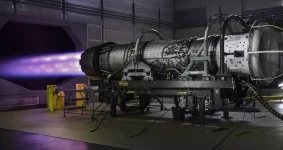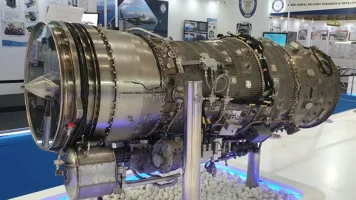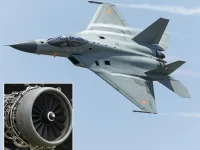- Views: 3K
- Replies: 8
India's ambition to achieve aerospace self-reliance with its Advanced Medium Combat Aircraft (AMCA), a 5.5-generation stealth fighter, is at a pivotal moment.
As global aerospace leaders like the United States, China, and European consortiums forge ahead with sixth-generation fighter technologies, India is strategically evaluating pathways to not only match these advancements but also to effectively address regional security dynamics, particularly concerning China’s J-20 stealth fighter and its evolving capabilities.
A prospective collaboration with the UK-led Tempest program, now part of the broader Global Combat Air Programme (GCAP) which includes Japan and Italy, presents a significant opportunity for India's AMCA. Securing access to Tempest's advanced engine technology, crucially with rights for local production, could dramatically enhance the AMCA.
More strategically, this partnership could lay a robust foundation for India to develop its own sixth- and even seventh-generation fighter jets, projecting its aerospace capabilities well into 2060. Recent reports in early May 2025 indicate that Japan has formally invited India to join the GCAP, aiming to distribute the substantial financial investment and deepen security cooperation.
The Tempest fighter, being developed by Team Tempest—a consortium featuring BAE Systems, Rolls-Royce, Leonardo, and MBDA—is envisioned as a sixth-generation platform for the Royal Air Force, Italian Air Force, and Japan Air Self-Defense Force, with an anticipated service entry around 2035. Its design incorporates cutting-edge features such as advanced stealth, artificial intelligence (AI)-driven mission systems, capabilities for optional manning, integration with swarm drones, and the potential for directed-energy weapons.
At the heart of Tempest's performance lies Rolls-Royce’s next-generation engine. This powerplant is reported to offer a tenfold increase in electrical power output, feature integrated electrical starter generators, and utilize adaptive cycle technology for superior fuel efficiency and thermal management – critical for powering advanced systems like lasers and supporting future hypersonic weapons, defining it as a cornerstone of sixth-generation propulsion.
Discussions regarding India's potential involvement with the Tempest program have been ongoing since 2019 and reportedly saw renewed interest in early 2025. Social media commentary reflects this optimism, with observations such as one highlighted by joysamcyborg on X (formerly Twitter), suggesting that India's capital, large defence market, and cost-effective production capabilities could synergize well with the cutting-edge technology offered by the UK and Japan. Participation in GCAP could grant India access to this advanced engine, with local manufacturing rights ensuring strategic independence and fostering significant economic benefits.
India’s flagship AMCA project, spearheaded by the Aeronautical Development Agency (ADA) and Hindustan Aeronautics Limited (HAL), aims to deliver a 5.5-generation stealth fighter by 2035. The initial version, AMCA Mk-1, is planned to be powered by General Electric’s F414 engine (producing 98 kN of thrust) and is expected to undertake its first flight by 2030, according to statements from DRDO officials in April 2025.
However, the subsequent AMCA Mk-2 variant, projected for around 2040, necessitates a more powerful engine in the 110–130 kN thrust class. This advanced engine is critical for achieving supercruise (supersonic flight without afterburners), maintaining stealth characteristics, and supporting sophisticated systems like AI-piloted drone wingmen and directed-energy weapons.
The Defence Research and Development Organisation (DRDO) is actively pursuing indigenous development of this engine in collaboration with a foreign partner, with ongoing negotiations reported with major aerospace engine manufacturers including General Electric, Safran, and Rolls-Royce. DRDO Chairman Dr. Samir V Kamat confirmed in April 2025 that the AMCA project received sanction in 2024 and is committed to a 2035 delivery timeline, also acknowledging plans to collaborate with a foreign Original Equipment Manufacturer (OEM) for aero-engine development to mitigate risks and shorten development time, citing lessons learned from the Kaveri engine program.
The development of such an advanced jet engine, estimated to cost between $4.5 to $5 billion, is fraught with significant technological challenges. Adaptive cycle engine technology, considered essential for sixth-generation fighters, remains a complex hurdle. A GE Aerospace official previously noted that a sixth-generation engine would likely require adaptive cycle technology similar to GE’s XA100, but co-development would demand substantial investment.
India's own Gas Turbine Research Establishment (GTRE) has faced considerable challenges with past projects, including the Kaveri engine, which, despite extensive testing, did not meet the higher thrust requirements for the LCA Tejas in its current form. This underscores the strategic importance of foreign expertise.
Gaining access to the Rolls-Royce engine from the Tempest program, designed with adaptive cycle features, could directly address this critical gap, offering a proven technological base for the AMCA Mk-2 while simultaneously building indigenous capabilities. Experts discussing the post-Kaveri roadmap have emphasized the need for greater synergy between academia, R&D, and industry for indigenous engine development.
Benefits of Tempest Engine Access for AMCA
A partnership centered on the Tempest engine could offer multifaceted advantages for India's aerospace and defence ambitions:- Technological Leap for AMCA Mk-2: The Rolls-Royce engine's adaptive cycle technology, which can offer significant improvements in range (potentially up to 30%) and acceleration (around 20%), would substantially boost the AMCA Mk-2’s operational performance. Its advanced thermal management and high electrical power generation are crucial for integrating sophisticated onboard systems, aligning the AMCA with emerging sixth-generation standards. Social media comments, such as one from @8r02s125558, suggest that integrating GCAP technology could bridge the capability gap between 5.5- and 6th-generation fighters for India.
- Local Production Rights and Self-Reliance: A key aspect of India's negotiations, particularly with Rolls-Royce, is securing local production rights. Manufacturing these advanced engines in India would drastically reduce import dependency, directly supporting the 'Atmanirbhar Bharat' (self-reliant India) initiative. As noted by @TheCluelessBong on X, such collaboration could "handhold our industry to learn complexities surrounding metallurgy and technicalities." Furthermore, indigenous production, potentially with full intellectual property rights (IPR) as reportedly offered by Rolls-Royce, could position India as an export hub for advanced aero-engines and components.
- Cost and Risk Sharing: The development cost for the Tempest program is estimated at approximately $32.5 billion. While India's potential contribution might be around $7.5 billion, this collaborative approach would mitigate the financial risks associated with developing such advanced technology independently. Access to Tempest’s engine technology would also reduce the estimated $4.5 billion required for a standalone AMCA engine development program. Leveraging Rolls-Royce’s experience from the Tempest program could also help minimize developmental delays.
- Strategic Alignment with Allies: Partnering with the UK, Japan, and Italy through the GCAP would significantly strengthen India’s geopolitical and defence relationships with these nations. This alignment could serve as a strategic counterweight to China's rapid advancements in aerospace technology. The GCAP consortium has indicated export ambitions, with India seen as a key potential market, which could ensure long-term support, upgrades, and collaborative evolution of the platform.
- Achieving 6th-Generation Capabilities by 2040: The AMCA Mk-2, if powered by a Tempest-derived engine, could realistically incorporate key sixth-generation features. These include AI-driven loyal wingman drones, advanced network-centric warfare capabilities, and directed-energy weapons, as envisioned for the Tempest. This would provide India with a credible deterrent against China’s own emerging sixth-generation fighter prototypes, helping to maintain air superiority in the strategically vital Indo-Pacific region. An observer status for India in the Tempest program could potentially evolve into deeper collaboration, allowing integration of other GCAP subsystems such as advanced radars and sensors into Indian platforms.
- Building a Foundation for 7th-Generation Fighters by 2060: A partnership on the Tempest engine would be instrumental in building India's indigenous expertise in critical future technologies like adaptive cycle engines, advanced AI algorithms, novel stealth materials, and cognitive warfare concepts. Seventh-generation platforms, anticipated to heavily emphasize these areas along with hypersonic weapon integration and potentially fully unmanned combat operations, would require a mature and robust industrial and technological ecosystem. Collaborative programs like AMCA with a Tempest-derived engine can catalyze the development of this ecosystem. Initiating conceptual work and capability development now, supported by such a partnership, would help India avoid the "catch-up trap" it has faced with some earlier indigenous defence programs.
- Growth of the Domestic Industrial Ecosystem: Local production of advanced aero-engines like the Tempest's would spur significant advancements across India’s domestic industry in materials science, advanced manufacturing processes, propulsion technology, and cybersecurity. This would, in turn, create numerous high-skill employment opportunities and encourage greater participation from the private sector. The planned dual production line model for the AMCA (involving both HAL and private sector partners) could be scaled to support these future, more advanced fighter programs, ensuring industrial scalability through 2060 and beyond.



